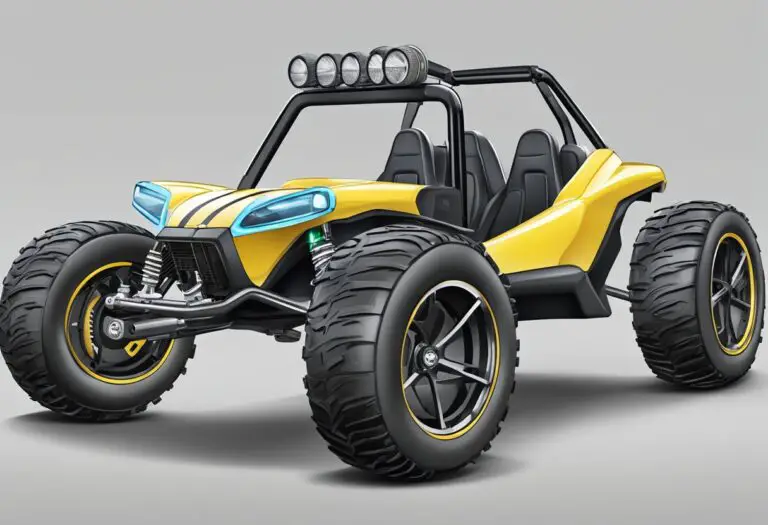Can You Make a Dune Buggy Street Legal? A Comprehensive Guide
Dune buggies are off-road vehicles that typically do not meet the requirements for street legality. However, many enthusiasts want to know whether they can make their dune buggy street legal. The answer is yes, but there are several factors to consider before doing so.

Understanding street legality is the first step in making a dune buggy street legal. The Department of Motor Vehicles (DMV) has strict regulations that prioritize the safety of vehicle operators and the environment. Therefore, it is necessary to ensure that the dune buggy meets the requirements for street legality before attempting to make it street legal.
Dune buggy modifications for street use, registration and documentation, state-specific regulations, inspection and compliance, legal challenges and solutions, cost analysis, and case studies are some of the factors to consider when making a dune buggy street legal. By taking these factors into account, enthusiasts can make their dune buggy street legal and enjoy the thrill of off-road exploration on public roads.
Key Takeaways
- Dune buggies can be made street legal, but it is important to understand street legality requirements and regulations.
- Dune buggy modifications, registration and documentation, state-specific regulations, inspection and compliance, legal challenges and solutions, and cost analysis are important factors to consider when making a dune buggy street legal.
- By taking these factors into account, enthusiasts can make their dune buggy street legal and enjoy off-road exploration on public roads.
Understanding Street Legality

Before attempting to make a dune buggy street legal, it is important to understand what street legality means. Street legal vehicles are those that are permitted to be driven on public roads. To be considered street legal, a vehicle must comply with all applicable safety and emissions regulations, and must be registered and insured.
When it comes to dune buggies, the regulations for street legality can vary by state and even by county. However, there are some common requirements that must be met in order to make a dune buggy street legal. These requirements typically include:
- Seat belts: Dune buggies must be equipped with seat belts that meet certain safety standards.
- Lights: Dune buggies must have working headlights, taillights, and turn signals.
- Windshield: A windshield is required in most states.
- Horn: A horn is required in most states.
- Muffler: A muffler is required in most states to reduce noise pollution.
In addition to these requirements, some states may have additional regulations that must be met in order to make a dune buggy street legal. For example, some states may require that the dune buggy be equipped with a certain type of tire or that it pass a certain type of emissions test.
It is important to note that modifying a dune buggy to make it street legal can be a complex and time-consuming process. It is recommended that anyone attempting to make a dune buggy street legal consult with local authorities and an experienced mechanic to ensure that all regulations are met and that the vehicle is safe to operate on public roads.
Dune Buggy Modifications for Street Use

When it comes to making a dune buggy street legal, there are several modifications that must be made to ensure compliance with safety, lighting, and environmental regulations. Here are some of the key modifications that are required:
Safety Requirements
One of the most important modifications that must be made to a dune buggy for street use is the installation of safety features. These include seat belts, a windshield, headlights, taillights, turn signals, and a horn. The seat belts must be securely fastened to the frame of the vehicle and must be able to withstand a significant amount of force in the event of an accident. The windshield must be made of safety glass and must be able to withstand impact from debris and other objects. The headlights, taillights, and turn signals must be bright enough to be seen from a reasonable distance and must be able to operate in all weather conditions.
Lighting and Electrical Systems
In addition to the safety requirements, there are also several modifications that must be made to the lighting and electrical systems of the dune buggy. This includes the installation of a battery, alternator, and wiring harness that can handle the increased electrical load of the additional lighting and safety features. The lighting system must also be designed to meet the requirements of the local jurisdiction, which may include specific color and brightness requirements for the headlights, taillights, and turn signals.
Emissions and Environmental Compliance
Finally, there are also emissions and environmental compliance requirements that must be met in order to make a dune buggy street legal. This includes the installation of a catalytic converter and muffler to reduce emissions and noise pollution. The dune buggy must also be equipped with a gas cap that can prevent fuel vapors from escaping into the atmosphere. In some jurisdictions, the dune buggy may also be required to undergo regular emissions testing to ensure that it is meeting the required emissions standards.
Overall, making a dune buggy street legal requires a significant amount of modifications and upgrades to ensure compliance with safety, lighting, and environmental regulations. It is important to consult with a qualified mechanic or automotive specialist to ensure that all of the necessary modifications are made and that the dune buggy is safe and legal for street use.
Registration and Documentation

Vehicle Title
To make a dune buggy street legal, the first step is to obtain a vehicle title. The title is a legal document that proves ownership of the vehicle. In most states, a dune buggy can be titled as a “constructed vehicle” or a “kit car.” It is important to check with the local Department of Motor Vehicles (DMV) for specific requirements and procedures for obtaining a vehicle title.
Registration Process
Once the dune buggy has been titled, it must be registered with the DMV. The registration process includes providing proof of ownership, proof of insurance, and payment of registration fees. In addition, the dune buggy must pass a safety inspection and emissions test, if required by the state. It is important to note that the registration process and requirements may vary depending on the state.
Insurance Considerations
Before driving a dune buggy on public roads, it is important to obtain proper insurance coverage. Liability insurance is required in most states to protect the driver and others in the event of an accident. Additional coverage, such as collision and comprehensive, may also be necessary depending on the value of the dune buggy. It is recommended to shop around for insurance quotes and compare coverage options to find the best policy for the dune buggy.
Overall, making a dune buggy street legal requires obtaining a vehicle title, registering the vehicle with the DMV, and obtaining proper insurance coverage. It is important to check with the local DMV for specific requirements and procedures for making a dune buggy street legal.
State-Specific Regulations

When it comes to making a dune buggy street legal, state-specific regulations must be taken into consideration. Here are the requirements for California, Florida, and Texas:
California Requirements
In California, dune buggies must meet certain requirements to be considered street legal. According to CVC Section 24008.5, the buggy must have the following features:
- Four-wheel brakes that are in good working condition
- A windshield made of safety glass or a shatter-resistant material
- Adequate headlights and taillights
- Turn signals, brake lights, and reflectors
- A horn that can be heard from at least 200 feet away
- A rearview mirror
- Seat belts for all passengers
- A muffler that meets the state’s noise level requirements
- A speedometer that is accurate and visible
Additionally, the dune buggy must pass a smog check if it was manufactured after 1976.
Florida Regulations
In Florida, dune buggies must meet the requirements set forth in Florida Statutes Section 316.212. These requirements include:
- Adequate brakes, including a parking brake
- A windshield made of safety glass or a shatter-resistant material
- Adequate headlights and taillights
- Turn signals, brake lights, and reflectors
- A horn that can be heard from at least 200 feet away
- A rearview mirror
- Seat belts for all passengers
- A muffler that meets the state’s noise level requirements
- A speedometer that is accurate and visible
Additionally, the dune buggy must pass a safety inspection before it can be registered.
Texas Legal Guidelines
In Texas, dune buggies are not considered street legal vehicles. However, there are some exceptions. For example, a dune buggy may be registered as a specially constructed vehicle if it meets certain requirements. These requirements include:
- The dune buggy must have a body that was not originally manufactured by a licensed manufacturer or distributor of motor vehicles
- The dune buggy must have a motor that was not originally manufactured by a licensed manufacturer or distributor of motor vehicles
- The dune buggy must meet the state’s safety and emissions standards
If the dune buggy meets these requirements, it may be registered as a specially constructed vehicle and used on public roads.
Inspection and Compliance

Safety Inspection
Before a dune buggy can be deemed street legal, it must pass a safety inspection. This inspection is to ensure that the vehicle is safe to operate on public roads. The inspection will check the vehicle’s brakes, lights, steering, tires, and other safety features. The inspection will also check the vehicle’s identification number to ensure that it matches the documentation.
Emissions Testing
In addition to the safety inspection, some states require emissions testing for dune buggies to be street legal. Emissions testing is to ensure that the vehicle meets the state’s emissions standards. The testing will check the vehicle’s exhaust system to ensure that it is not emitting harmful pollutants into the environment.
It is important to note that the emissions testing requirements vary from state to state. Some states do not require emissions testing for dune buggies, while others have strict emissions standards that must be met. It is recommended to check with the local Department of Motor Vehicles to determine the emissions testing requirements for a specific state.
In conclusion, making a dune buggy street legal requires passing a safety inspection and potentially passing emissions testing. The specific requirements for inspection and compliance vary from state to state, so it is important to check with the local Department of Motor Vehicles to ensure compliance with state regulations.
Legal Challenges and Solutions

When it comes to making a dune buggy street legal, there are several legal challenges that one may face. However, with proper navigation and handling, these challenges can be overcome. In this section, we will discuss some of the common legal challenges and solutions.
Navigating Zoning Laws
One of the major legal challenges that one may face when making a dune buggy street legal is navigating zoning laws. Zoning laws are regulations that dictate how land can be used in a particular area. In some areas, dune buggies may not be allowed on public roads or may only be allowed on certain roads. Therefore, it is important to check with the local zoning board to determine if there are any restrictions on the use of dune buggies on public roads.
Handling Legal Disputes
Another legal challenge that one may face when making a dune buggy street legal is handling legal disputes. Legal disputes can arise if a dune buggy is involved in an accident or if it is found to be in violation of any laws or regulations. Therefore, it is important to have proper documentation and registration for the dune buggy. Additionally, it is important to have proper insurance coverage to protect against any legal disputes that may arise.
In conclusion, making a dune buggy street legal can be a challenging process, but with proper navigation and handling, it can be done. By understanding and complying with local zoning laws and having proper documentation, registration, and insurance coverage, one can overcome the legal challenges and enjoy the thrill of driving a street legal dune buggy.
Cost Analysis

Modification Expenses
Making a dune buggy street legal requires a variety of modifications to ensure that it meets the necessary safety and emissions requirements. These modifications can be costly, and the total expense will depend on the specific make and model of the dune buggy.
Some of the modifications that may be required include adding turn signals, brake lights, and mirrors, as well as installing a windshield and a horn. Additionally, the dune buggy may need to be equipped with seat belts and a roll cage for added safety.
The cost of these modifications can vary widely depending on the type of dune buggy and the specific requirements of the state in which it is being registered. It is important to research the specific regulations in your state and obtain a detailed quote from a reputable mechanic or auto shop before beginning any modifications.
Legal and Registration Costs
In addition to the cost of modifications, there are also legal and registration costs associated with making a dune buggy street legal. These costs can include registration fees, title fees, and taxes, as well as any required inspections or emissions testing.
The exact costs associated with registering a dune buggy will vary depending on the state in which it is being registered and the specific requirements of that state. Some states may require additional fees or inspections for vehicles that have been modified for street use.
It is important to research the specific requirements and costs associated with registering a dune buggy in your state before beginning any modifications. This will help you to ensure that you are prepared for all of the associated expenses and can budget accordingly.
Overall, making a dune buggy street legal can be a costly process, but it is necessary to ensure that the vehicle is safe and legal for use on public roads. By researching the specific requirements in your state and obtaining detailed quotes for any necessary modifications, you can ensure that you are prepared for all of the associated costs.




